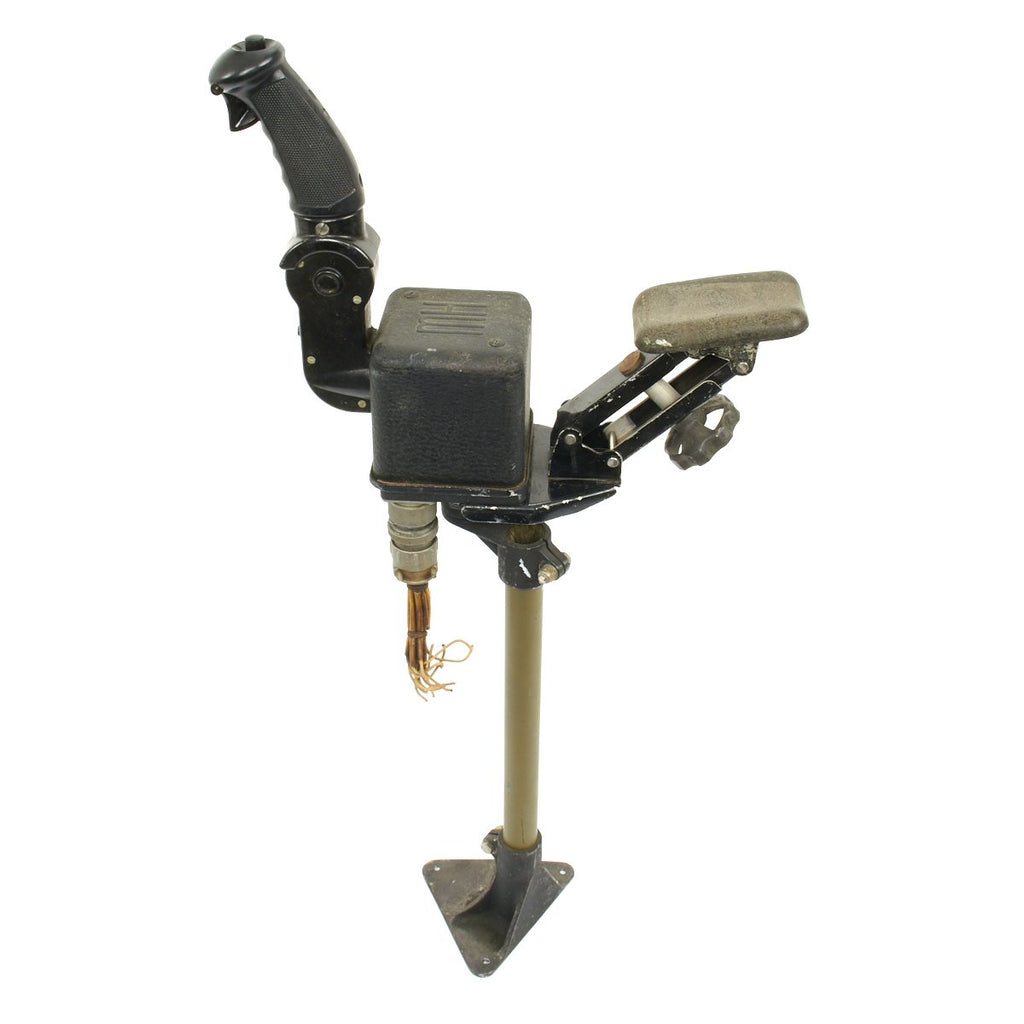Item Description
Original Item: Only One Available. This is just amazing, a genuine vintage World War Two Boeing B-17 Flying Fortress pilot’s complete C-1 Autopilot Formation Control Stick Assembly. This is the only complete C-1 Autopilot Formation Control Stick we have ever seen outside an airplane, a very rare piece of iconic WW2 equipment just perfect for your home or office!
Dimensions 31 H x 17 x 4
The World War II formation control stick was used with the C1 autopilot for the Norden bombsights used on B17, B24 and B29 bombers. A requirement for the successful use of the Norden bomb-sight was a steady and controllable aircraft platform achieved by use of a gyroscopic autopilot. Minnesota Honeywell Regulator Company developed and produced the C1 autopilot as an improvement over the original Sperry Gyroscope auto pilot.
This formation stick was an improvement added to the original C1 autopilot. The original C-1 autopilot required turning rotary knobs for course corrections and control of the plane, when the Norden bombsight was not controlling it. This formation stick was mounted to the left of the pilot and right of the co-pilot where the armrest would be. It allowed an easier control of the plane when flying formation to the bomb site. It also had a trigger switch for use of the communication microphone and a transfer switch on top for transferring control between the pilot and co-pilot.
These Formation Control Sticks were part of the first mass produced fly by wire aircraft control system. The electronic "fly by wire" control is now used on many of today's modern aircraft.
This formation stick was manufactured by the original manufacturer and still has its original data plate that reads Minnesota Honeywell Regulator Co. The mechanical components all function properly and look to be in good shape. We have not put electrical power to the unit since we do not know the specifications for input or output. It comes complete with the arm rest, mount stand and wiring which appears to never have been connected meaning that this example may be an unissued NOS example!
On July 28, 1935, a four-engine plane took off from Boeing Field in south Seattle on its first flight. Rolling out of the Boeing hangar, it was simply known as the Model 299. Seattle Times reporter Richard Smith dubbed the new plane, with its many machine-gun mounts, the Flying Fortress, a name that Boeing quickly adopted and trademarked. The U.S. Army Air Corps designated the plane as the B-17.
In response to the Army’s request for a large, multiengine bomber, the prototype, financed entirely by Boeing, went from design board to flight test in less than 12 months.
The B-17 was a low-wing monoplane that combined aerodynamic features of the XB-15 giant bomber, still in the design stage, and the Model 247 transport. The B-17 was the first Boeing military aircraft with a flight deck instead of an open cockpit and was armed with bombs and five .30-caliber machine guns mounted in clear blisters.
The first B-17s saw combat in 1941, when the British Royal Air Force took delivery of several B-17s for high-altitude missions. As World War II intensified, the bombers needed additional armament and armor.
The B-17E, the first mass-produced model Flying Fortress, carried nine machine guns and a 4,000-pound bomb load. It was several tons heavier than the prototypes and bristled with armament. It was the first Boeing airplane with the distinctive and enormous tail for improved control and stability during high-altitude bombing. Each version was more heavily armed.
In the Pacific, the planes earned a deadly reputation with the Japanese, who dubbed them four-engine fighters. The Fortresses were also legendary for their ability to stay in the air after taking brutal poundings.
Seventy-five years after the B-17’s first flight, an 88 year-old veteran sent The Boeing Company a letter. After explaining how he returned to England after a bombing raid over Germany with 179 flak holes and only two out of the four engines, he wrote: I’m glad to be alive. Thank you for making such a good airplane.
Gen. Carl Spaatz, the American air commander in Europe, said, Without the B-17 we may have lost the war.
- This product is available for international shipping.
- Eligible for all payments - Visa, Mastercard, Discover, AMEX, Paypal & Sezzle





















